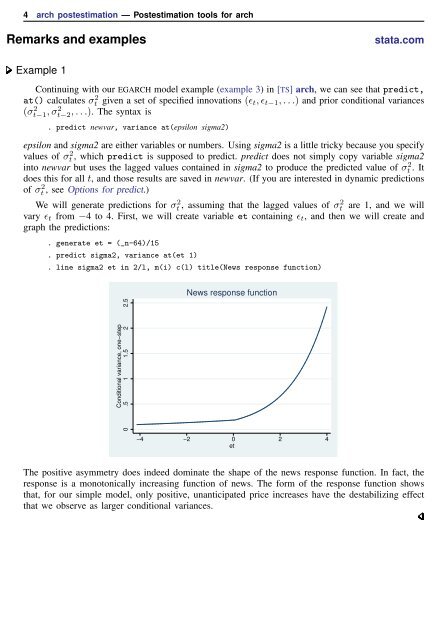arch postestimation - Stata
arch postestimation - Stata
arch postestimation - Stata
You also want an ePaper? Increase the reach of your titles
YUMPU automatically turns print PDFs into web optimized ePapers that Google loves.
4 <strong>arch</strong> <strong>postestimation</strong> — Postestimation tools for <strong>arch</strong><br />
Remarks and examples<br />
stata.com<br />
Example 1<br />
Continuing with our EGARCH model example (example 3) in [TS] <strong>arch</strong>, we can see that predict,<br />
at() calculates σ 2 t given a set of specified innovations (ɛ t, ɛ t−1 , . . .) and prior conditional variances<br />
(σ 2 t−1, σ 2 t−2, . . .). The syntax is<br />
. predict newvar, variance at(epsilon sigma2)<br />
epsilon and sigma2 are either variables or numbers. Using sigma2 is a little tricky because you specify<br />
values of σt 2 , which predict is supposed to predict. predict does not simply copy variable sigma2<br />
into newvar but uses the lagged values contained in sigma2 to produce the predicted value of σt 2. It<br />
does this for all t, and those results are saved in newvar. (If you are interested in dynamic predictions<br />
of σt 2 , see Options for predict.)<br />
We will generate predictions for σt 2, assuming that the lagged values of σ2 t are 1, and we will<br />
vary ɛ t from −4 to 4. First, we will create variable et containing ɛ t , and then we will create and<br />
graph the predictions:<br />
. generate et = (_n-64)/15<br />
. predict sigma2, variance at(et 1)<br />
. line sigma2 et in 2/l, m(i) c(l) title(News response function)<br />
News response function<br />
Conditional variance, one−step<br />
0 .5 1 1.5 2 2.5<br />
−4 −2 0 2 4<br />
et<br />
The positive asymmetry does indeed dominate the shape of the news response function. In fact, the<br />
response is a monotonically increasing function of news. The form of the response function shows<br />
that, for our simple model, only positive, unanticipated price increases have the destabilizing effect<br />
that we observe as larger conditional variances.
















